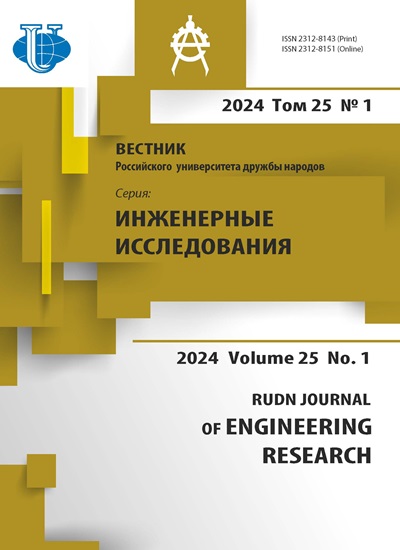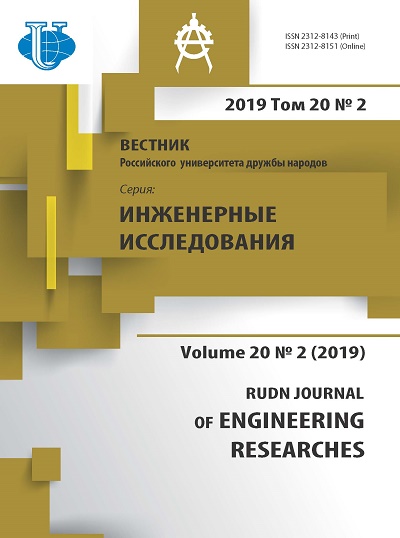Use of residual rock strength in bearing structures in underground ore mining
- Authors: Golik V.I.1,2, Dmitrak Y.V.2, Gabaraev O.Z.2, Razorenov Y.I.3
-
Affiliations:
- Geophysical Institute of the Vladikavkaz Scientific Center of the Russian Academy of Sciences
- North Caucasian Institute of Mining and Metallurgy (State Technological University)
- Platov South-Russian State Polytechnic University (NPI)
- Issue: Vol 20, No 2 (2019)
- Pages: 193-203
- Section: Earth science
- URL: https://journals.rudn.ru/engineering-researches/article/view/22678
- DOI: https://doi.org/10.22363/2312-8143-2019-20-2-193-203
Cite item
Full Text
Abstract
The relevance of the study is explained by the need to improve technological processes with the increasing complexity of the development of ore deposits with an increase in the depth of development, the use of powerful technology and an increase in stresses in arrays of ore-bearing rocks. The need to minimize the risk of mining requires the development and use of tools for managing an array. The purpose of this study is to systematize information about the theory and practice of using the residual bearing capacity of destroyed rocks from the practice of underground mining to improve the methods used to control the geomechanics of ore-bearing arrays. The complex of research includes analytical, full-scale, laboratory and theoretical methods that are used to identify the phenomenon of the use of the residual carrying capacity of destroyed rocks. To achieve this goal information on the use of bearing floors made of intact and destroyed ores and rocks, as well as other materials, is systematized. A brief description of the scientific support of mining engineering tasks is given. The phenomenon of the use of residual bearing capacity of disturbed rocks in the structure arising in the mountain massif is characterized. A critical analysis of the concepts of array management is given. Considered alternative options for creating structures for solving problems of reducing the health risk of workers and improving the quality of ores. A new typification of structures using the residual strength of destroyed rocks is given. It has been proved that in underground mining there is an opportunity to realize the residual bearing capacity of the destroyed rocks to create structures with desired properties, which contributes to solving the tasks of labor protection and improving the quality of ores.
About the authors
Vladimir I. Golik
Geophysical Institute of the Vladikavkaz Scientific Center of the Russian Academy of Sciences; North Caucasian Institute of Mining and Metallurgy (State Technological University)
Author for correspondence.
Email: v.i.golik@mail.ru
chief researcher at the GPI VSC RAS; Professor of Department of Mining of North Caucasian Institute of Mining and Metallurgy (State Technological University), Doctor of Technical Sciences, Professor
93а Markova St., Vladikavkaz, 362002, Russian Federation; 44 Nikolaeva St., Vladikavkaz, 362021, Russian FederationYury V. Dmitrak
North Caucasian Institute of Mining and Metallurgy (State Technological University)
Email: v.i.golik@mail.ru
Rector of the North Caucasian Institute of Mining and Metallurgy (State Technological University), Doctor of Technical Sciences, Professor
44 Nikolaeva St., Vladikavkaz, 362021, Russian FederationOleg Z. Gabaraev
North Caucasian Institute of Mining and Metallurgy (State Technological University)
Email: v.i.golik@mail.ru
Head of Department of Mining of North Caucasian Institute of Mining and Metallurgy (State Technological University), Doctor of Technical Sciences, Professor
44 Nikolaeva St., Vladikavkaz, 362021, Russian FederationYuri I. Razorenov
Platov South-Russian State Polytechnic University (NPI)
Email: v.i.golik@mail.ru
rector in charge of SRSPU (NPI), Doctor of Engineering Sciences, Professor
132 Prosveshcheniya St., Novocherkassk, 346428, Russian FederationReferences
- Golik VI, Razorenov YuI, Lyashenko VI. Nesushchie porodnye konstrukcii pri osvoenii podzemnyh ob"ektov [Bearing rock structures in the development of underground objects]. Structural Mechanics of Engineering Constructions and Buildings. 2017;(2): 48–57. (In Russ.)
- Golik VI, Razorenov YuI, Lyashenko VI. Prochnost' porodnyh konstrukcij pri podzemnom stroitel'stve [The strength of rock structures in underground construction.] Structural Mechanics of Engineering Constructions and Buildings. 2017;(4): 57–65. (In Russ.)
- Haeri H, Shahriar K, Fatehi Marji M, Moarefvand P. Experimental and pre-cracked rock-like disks. International Journal of Rock Mechanics and Mining Sciences. 2014;67: 20–28.
- Kuranov AD, Sidorov DV. Ocenka napryazhennogo sostoyaniya mezhdushtrekovyh celikov na rudnikah OAO “Apatit” [Evaluation of the tense state of the intertrack pillars in the mines of OJSC “Apatit”]. News of Tula State University. Earth Sciences. 2011;(1): 308–312.
- Lyashenko VI. Razvitie geomekhanicheskogo monitoringa svojstv i sostoyaniya massiva gornyh porod pri podzemnoj razrabotke mestorozhdenij slozhnoj struktury [Development of geomechanical monitoring of the properties and state of the rock mass during underground mining of complex structures]. Marksheydersky Bulletin. 2016;(1): 35–43. (In Russ.)
- Protosenya AG, Kuranov AD. Мetodika prognozirovaniya napryazhenno-deformirovannogo sostoyaniya gornogo massiva pri kombinirovannoj razrabotke Koashvinskogo mestorozhdeniya [Method of forecasting the stressstrain state of a mountain massif with the combined development of the Koashvinskoe deposit]. Gornyi zhurnal. 2015;(1): 67–71. (In Russ.)
- Rylnikova MV, Emelyanenko EA, Angelov NA. Formirovanie tekhnogennogo massiva iz hvostov obogashcheniya v otrabotannom prostranstve s zadannymi strukturnymi parametrami [Formation of a technogenic massif from enrichment tails in a spent space with given structural parameters]. Mining informational and analytical bulletin. 2013;(1): 115. (In Russ.)
- Shojaei A, Dahi Taleghani A, Li G. A continuum damage failure model for hydraulic fracturing of porous rocks. International Journal of Plasticity. 2014;59: 199–212.
- Pleshko M, Meskhi B, Pleshko M. Novyj metod rascheta ob"edinennoj anker-betonnoj opory podzemnyh sooruzhenij [New method for calculating the combined anchor-concrete support of underground structures]. MATEC Web of Conferences. 2018;170: 03023. Available from: doi.org/10.1051/matecconf/201817003023. (In Russ.)
- Yunjin H, Guolong C, Weiping C, Zhenjun Y. Simulation of hydraulic fracturing in rock mass using a smeared crack model. Computers and Structures. 2014; 137: 72–77.
- Molev MD, Maslennikov SA, Zanina IA, Stuzhenko NI. Prognozirovanie sostoyaniya tekhnosfernoj bezopasnosti: monografiya [Forecasting the state of technosphere safety: monograph]. Shakhty: ISOiP (branch) DGTU; 2015. (In Russ.)
- Golik VI, Dmitrak YuV, Gabaraev OZ, Kozhiev KhH. Minimizaciya vliyaniya gornogo proizvodstva na okruzhayushchuyu sredu [Minimizing the impact of mining on the environment]. Ecology and Industry of Russia. 2018;22(6): 26–29. (In Russ.)
- Golik VI, Dmitrak YuV, Komaschenko VI, Razorenov YuI. Ekologicheskie aspekty hraneniya hvostov obogashcheniya rud v gornom regione [Ecological aspects of storage of ore dressing tailings in a mountainous region]. Ecology and industry of Russia. 2018;22(6): 35–39. (In Russ.)
- Stas GV, Smirnova EV. Travmatizm i professional'nye zabolevaniya na gornyh predpriyatiya [Traumatism and occupational diseases in mining enterprises]. News of Tula State University. Series: Earth Sciences. 2015;(1): 30–42. (In Russ.)
















